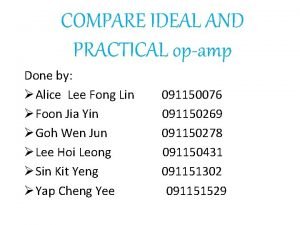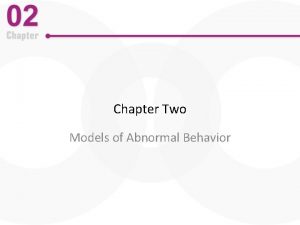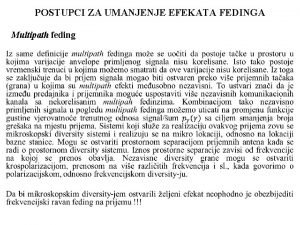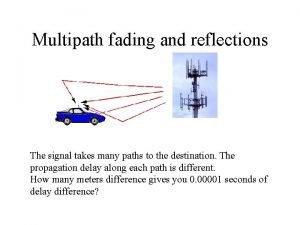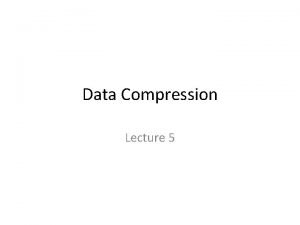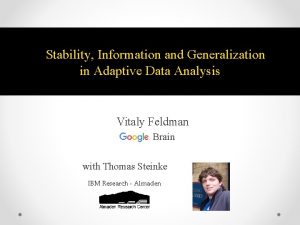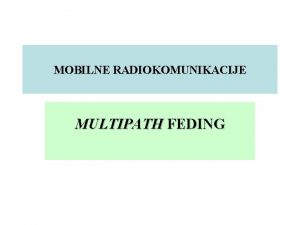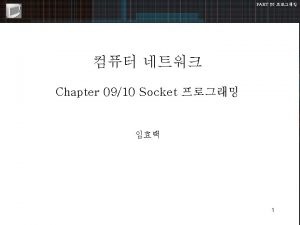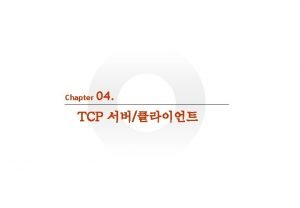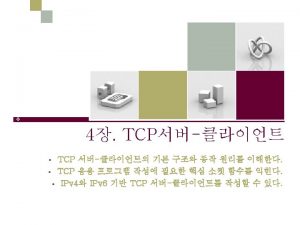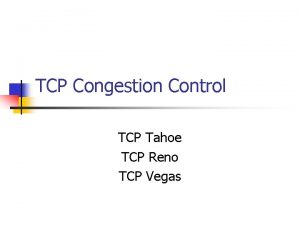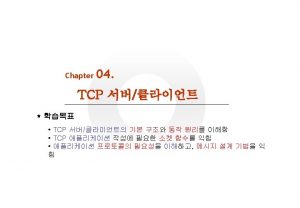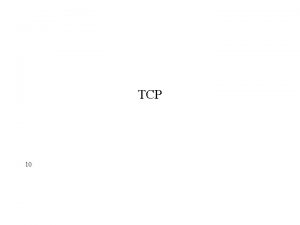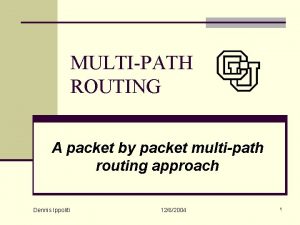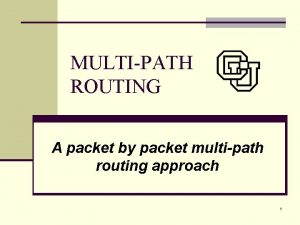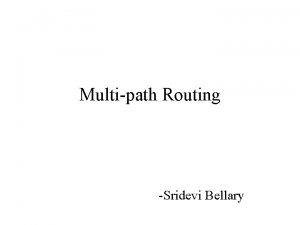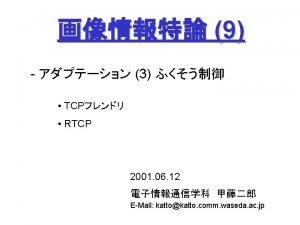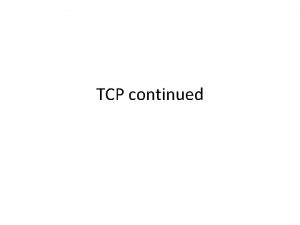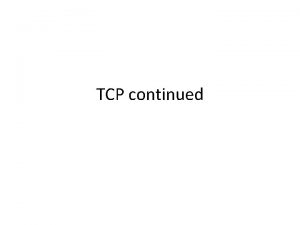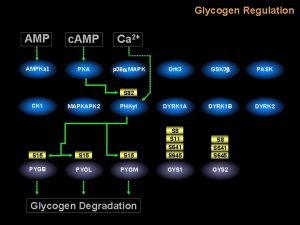AMP An Adaptive Multipath TCP for Data Center


















- Slides: 18

AMP: An Adaptive Multipath TCP for Data Center Networks Morteza Kheirkhah Myungjin Lee University College London, UK University of Edinburgh, UK IFIP Networking 2019 1

Data centre networks (DCN) • Various applications with diverse communication patterns and requirements – Some apps are bandwidth hungry (online file storage); some others are latency sensitive (online search) • Short flow dominance – Majority of network flows are short-lived with deadline in their flow completion time (FCT). These flows typically cause sudden burst in traffic – Majority of data volumes come from a few (long) flows It is challenging to provide high throughput and low latency communications in highly dynamic network conditions 2

Network congestion in DCNs • Transient congestion: Many short flows collide on a link (in a synchronized fashion) • Persistent congestion: a few long flows collide on a link (typically due to poor load-splitting of the ECMP routing) 3

Existing solutions Transient congestion DCTCP … Low latency Good for mice flows Transient & Persistent XMP DCM (our prior work) Persistent congestion MPTCP … High throughput Good for elephant flows Good for all flows ECN-based multipath schemes seem to provide a good balance between the latency-throughput trade-off 4

Problems with ECN-capable variant of MPTCP • TCP Incast – Well-studied topic for TCP (not really for MPTCP) • Last Hop Unfairness (LHU) – We are reporting it for the first time 5

Problem 1: Incast • MPTCP and its ECN-capable variants are not robust against the Incast problem – More subflows --> More packets --> Buffer overflow --> Higher chance of RTO in each subflow especially when the congestion window is small 200 ms S 1 SF 2 SF 3 200 ms S 2 SF 1 SF 2 SF 3 200 ms S 3 SF 2 SF 1 S 4 SF 3 SF 2 SF 1 RTO DROP 6

Incast in practice Better Experiment setup MPTCP has 4 subflows RTT 20 us Flow size 128 KB Link rate 10 Gbps Buffer size 100 pkts Multipath schemes complete their flows by 1 -2 orders of magnitude longer than DCTCP 7

Problem 2: Last Hop Unfairness • • Let’s assume: – Propagation delay is zero – Marking threshold (K) at switches sets to 4 packets (K=4) – Minimum congestion window size sets to one packet (cwnd min=1) Normal situation Persistent buffer inflation Two single-path flows • A new arriving packet • share the link fairly. always finds the queue Each flow generating size equal to K. Each flow two packets per RTT is thus forced to reduce on average its cwnd to one packet Last hop unfairness The multipath flow (S 5) with 4 subflows sending four times more packets than single-path flows The LHU leads to severe unfairness and significantly 8 escalates the likelihood of persistent buffer inflation

LHU in practice Unfair Experiment setup 8 DCTCP flows competing with one XMP flow Fair X-axis shows the number of XMP’s subflows in each experiment Y-axis shows the mean goodput As the number of XMP’s subflows increases, the impact of LHU problem increases 9

Incast vs. LHU (recap) INCAST LHU Marking Threshold (K) Maximum queue size DROP 10

Our solution Adaptive Multi. Path (AMP) a multipath congestion control algorithm for data center networks 11

AMP design • Our key observation: – When all subflows of a multipath flow have the smallest cwnd value (and their packets are ECN-marked), it is a good indicator that the subflows are at the same bottleneck link (facing severe congestion) • Subflow suppression/release algorithms: – Suppression: AMP deactivates all subflows but one, when the minimum window state across all subflows remains for a small time period (e. g. , 2 RTTs) – Release: AMP reactivates all suspended subflows when it no longer receives ECN-marked packets for some time period (e. g. , 8 RTTs) AMP behaves like a single-path flow once it detects the LHU condition 12

AMP also simplifies congestion control operation • We make a few observations: – When ECN is used in a DCN, RTT measurements of subflows are unnecessary for updating their cwnd – DCTCP-like window reduction slows down traffic shifting • AMP’s congestion control algorithm 13

AMP under LHU No. of multipath flows = 1 No. of subflow = 4 No. of multipath flows = 4 No. of subflow = 4 Better No LHU Severe LHU 14

AMP under Incast Flow Size of 128 KB Better AMP can be used for both short and long flows 15

Summary • Existing multipath congestion control schemes fail to handle: 1. The TCP incast problem that causes temporal switch buffer overflow due to synchronized traffic arrival 2. The last hop unfairness that causes persistent buffer inflation and serious unfairness • We designed AMP to effectively overcome these problems: – AMP adaptively switches its operation between a multiple-subflow and single-subflow mode 16

Source code • As part of AMP project, I have implemented (from scratch) several networking protocols in ns-3. 19 including MPTCP, DCM, XMP and DCTCP. • The AMP source code is available publicly from (my Git. Hub) https: //github. com/mkheirkhah 17

Thank You! 18
 Ideal & practical
Ideal & practical One dimensional model psychology
One dimensional model psychology Multipath
Multipath Multipath
Multipath Multipath model of anxiety disorders
Multipath model of anxiety disorders Multipath reflection
Multipath reflection Data center tcp (dctcp)
Data center tcp (dctcp) Adaptive huffman
Adaptive huffman Preserving statistical validity in adaptive data analysis
Preserving statistical validity in adaptive data analysis Adaptive data analysis
Adaptive data analysis Data offset in tcp
Data offset in tcp Rdt 3.0 receiver fsm
Rdt 3.0 receiver fsm Kontinuitetshantering i praktiken
Kontinuitetshantering i praktiken Novell typiska drag
Novell typiska drag Tack för att ni lyssnade bild
Tack för att ni lyssnade bild Vad står k.r.å.k.a.n för
Vad står k.r.å.k.a.n för Varför kallas perioden 1918-1939 för mellankrigstiden?
Varför kallas perioden 1918-1939 för mellankrigstiden? En lathund för arbete med kontinuitetshantering
En lathund för arbete med kontinuitetshantering Adressändring ideell förening
Adressändring ideell förening
